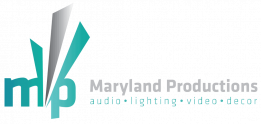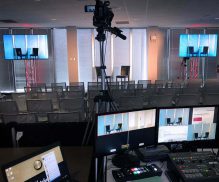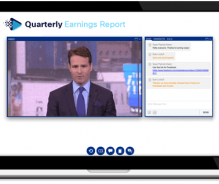
Webcasting & Live Streaming
Everything you need to know about hosting a Virtual Event!
What is Webcasting?
A combination of the words “web” and “broadcast”
The process of video broadcasting a media presentation live over the internet. This technology operates in real-time and allows for active conversations among and between the web-caster and their viewers.
- Webcasts can be audio, video and presentation content, or a mix of all three.
- Webcasts can either be distributed live or on demand depending on the clients needs.
What are the Key Benefits of Broadcasting?

EXTEND THE REACH OF YOUR AUDIENCE
Webcasts are location flexible, meaning your attendees can stream your event wherever they are! This ease of access gives them a better chance of attending!

DETAILED MULTI-DIMENSIONAL
RECORD
An on-demand version of the webcast is available immediately after a live broadcast. This record not only serves as great internal reference material, it also increases exposure by allowing missed attendees to see it.

ACTIVE AUDIENCE INVOLVEMENT
Webcasts aren't one-way conversations, webcasts offer; ‘ask a question’, live chat, polls and surveys. It is also easy to share webcasts via social media or to integrate them with a live Twitter feed.

BRAND AWARENESS
Webcasts allow your audiences to have a visual image of your brand and a single point of contact to build your customer-brand relationship. Branding templates allow clients to choose images, fonts, styles, customized registration forms and email notifications.
How does webcasting work?
All webcasts, whether massive prerecorded events or small, live discussions, make use of the same basic 5 steps:
1
CAPTURE
The images and the sound for the event are captured using the proper conferencing equipment. Clients can use their own equipment or professional equipment. Whether you are using a single screen display or integrating a split screen with a PowerPoint presentation and live camera, having the necessary equipment is crucial.
2
OUTPUT
The output from the capturing equipment gets fed into a computer using a conferencing interface (via computer) and allows the broadcast to happen.
3
ENCODING
The video and audio is encoded into a live stream that can then be served to a webcast player. The computer has a specific software on it that turns the input into a format that works with live streaming.
4
TRANSMISSION
The encoded video and audio is sent over the Internet to a streaming server. Some clients have their own private server for this, or a professionally made microsite player or embed player that can sit on their website, or event landing page so people can watch.
5
BROADCAST
The stream gets picked up by the server and is broadcast in real time to anyone viewing it on the web site. You can choose how that’s done and where the webcast is watched. You can have multiple streams on a webcast, so you can serve it to a service like Facebook Live as well as to your website, or YouTube, allowing you to reach different, specific, audiences.
Webcasting/ Live-Streaming
WE APPROACH EVERY WEBCAST/LIVE-STREAM AS A LIVE EVENT PRODUCTION
We provide everything you need to broadcast your event live!
© 2021 MARYLAND PRODUCTIONS & MARYLAND EVENT SERVICES. ALL RIGHTS RESERVED.